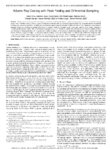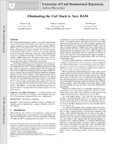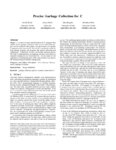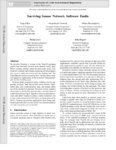1 - 25 of 24
Number of results to display per page
| Creator | Title | Description | Subject | Date | ||
|---|---|---|---|---|---|---|
| 1 |  | Sikorski, Kris | A note on optimal algorithms for fixed points | We present a constructive lemma that we believe will make possible the design of nearly optimal 0(dlog | ) cost algorithms for computing eresidual approximations to the fixed points of d-dimensional nonexpansive mappings with respect to the infinity norm. This lemma is a generalization of a two-... | Fixed points; Constructive lemma | 2009 |
| 2 |  | Riloff, Ellen M. | Conundrums in noun phrase coreference resolution: making sense of the state-of-the-art | We aim to shed light on the state-of-the-art in NP coreference resolution by teasing apart the differences in the MUC and ACE task definitions, the assumptions made in evaluation methodologies, and inherent differences in text corpora. First, we examine three subproblems that play a role in coref... | Noun phrase; Coreference resolution; MUC; ACE | 2009 |
| 3 |  | Riloff, Ellen M. | Corpus-based semantic lexicon induction with web-based corroboration | Various techniques have been developed to automatically induce semantic dictionaries from text corpora and from the Web. Our research combines corpus-based semantic lexicon induction with statistics acquired from the Web to improve the accuracy of automatically acquired domain-specific dictionari... | Corpus-based; Text corpora; Domain-specific dictionaries; Bootstrapping algorithm | 2009 |
| 4 |  | Li, Guodong; Gopalakrishnan, Ganesh; Kirby, Robert Michael II | Formal specification of MPI 2.0: case study in specifying a practical concurrent programming API | We describe the rst formal speci cation of a non-trivial subset of MPI, the dominant communication API in high performance computing. Engineering a formal speci cation for a non-trivial concurrency API requires the right combination of rigor, executability, and traceability, while also serving a... | MPI 2.0 | 2009 |
| 5 |  | Humphrey, Alan Parker; Derrick, Christopher Glade; Gopalakrishnan, Ganesh | GEM: graphical explorer for MPI programs | Formal dynamic verification can complement MPI program testing by detecting hard-to-find concurrency bugs. In previous work, we described our dynamic verifier called ISP that can parsimoniously search the execution space of an MPI program while detecting important classes of bugs. One major limit... | GEM; Graphical explorer; MPI programs; Dynamic verification; Concurrency bugs | 2009 |
| 6 |  | Henderson, Thomas C.; Cohen, Elaine | Innate theories as a basis for autonomous mental development | Sloman (in robotics), Chomsky and Pinker (in natural language), and others, e.g., Rosenberg (in human cooperative behavior) have proposed that some abstract theories relevant to cognitive activity are encoded genetically in humans. The biological advantages of this are (1) to reduce the learning ... | Autonomous mental development | 2009 |
| 7 |  | Balasubramonian, Rajeev | Interference aware cache designs for operating system execution | Large-scale chip multiprocessors will likely be heterogeneous. It has been suggested by several groups that it may be worthwhile to implement some cores that are specially tuned to execute common code patterns. One such common application that will execute on all future processors is of course the ... | Interference aware; Cache designs; Off-loading | 2009 |
| 8 |  | Freire, Juliana | Introducing the VisTrails Provenance Explorer Plugin for ParaView | In order to analyze and validate various hypotheses, it is necessary to create insightful visualizations of both the simulated processes and observed phenomena, using powerful data analysis and visualization tools like ParaView. But to explore data through visualization, scientists need to go thro... | VisTrails; Provenance; ParaView | 2009 |
| 9 |  | Riloff, Ellen M. | Learning and evaluating the content and structure of a term taxonomy | In this paper, we describe a weakly supervised bootstrapping algorithm that reads Web texts and learns taxonomy terms. The bootstrapping algorithm starts with two seed words (a seed hypernym (Root concept) and a seed hyponym) that are inserted into a doubly anchored hyponym pattern. In alternatin... | Weakly supervised; Bootstrapping algorithm; Seed hypernym; Seed hyponym; Root concept; Term taxonomy; Learning by reading systems | 2009 |
| 10 |  | Balasubramonian, Rajeev | Non-uniform power access in large caches with low-swing wires | Modern processors dedicate more than half their chip area to large L2 and L3 caches and these caches contribute significantly to the total processor power. A large cache is typically split into multiple banks and these banks are either connected through a bus (uniform cache access - UCA) or an on-c... | Large caches; Low-swing wires; Non Uniform Cache Access; NUCA | 2009 |
| 11 |  | Kirby, Robert Michael II | On the use of adjoint-based sensitivity estimates to control local mesh refinement | The goal of efficient and robust error control, through local mesh adaptation in the computational solution of partial differential equations, is predicated on the ability to identify in an a posteriori way those localized regions whose refinement will lead to the most significant reductions in the ... | Sensitivity; Adaptivity; Error estimation; hp-finite elements; Discrete adjoint; Mesh refinement | 2009 |
| 12 |  | Sikorski, Christopher; Pardyjak, Eric R. | Source characterization of atmospheric releases using quasi-random sampling and regularized gradient optimization | In the present work, an inversion technique to solve the atmospheric source characterization problem is described. The inverse problem comprises characterizing the source (x, y and z coordinates and the source strength) and the meteorological conditions (wind speed and wind direction) at the sourc... | Source characterization; Gaussian plume model; Quasi-Monte Carlo (QMC); Regularization; Newton?s method; Line-search; Tikhonov stabilizing functional; Adaptive regularization | 2009 |
| 13 |  | Henderson, Thomas C.; Cohen, Elaine | Symmetry as an organizational principle in cognitive sensor networks | Cognitive sensor networks are able to perceive, learn, reason and act by means of a distributed, sensor/actuator, computation and communication system. In animals, cognitive capabilities do not arise from a tabula rasa, but are due in large part to the intrinsic architecture (genetics) of the ani... | Cognitive sensor networks | 2009 |
| 14 |  | Riloff, Ellen M. | Toward completeness in concept extraction and classification | Many algorithms extract terms from text together with some kind of taxonomic classification (is-a) link. However, the general approaches used today, and specifically the methods of evaluating results, exhibit serious shortcomings. Harvesting without focusing on a specific conceptual area may deliv... | Concept extraction; Concept classification | 2009 |
| 15 |  | Riloff, Ellen M. | Unified model of phrasal and sentential evidence for information extraction | Information Extraction (IE) systems that extract role fillers for events typically look at the local context surrounding a phrase when deciding whether to extract it. Often, however, role fillers occur in clauses that are not directly linked to an event word. We present a new model for event extract... | Information extraction; Phrasal evidence; Sentential evidence; Role fillers; Event extraction; Sentential event recognizer; Plausible roll-filler recognizer | 2009 |
| 16 |  | Balasubramonian, Rajeev | Dynamic hardware-assisted software-controlled page placement to manage capacity allocation and sharing within large caches | In future multi-cores, large amounts of delay and power will be spent accessing data in large L2/L3 caches. It has been recently shown that OS-based page coloring allows a non-uniform cache architecture (NUCA) to provide low latencies and not be hindered by complex data search mechanisms. In this ... | Page coloring; Shadow-memory addresses; Cache capacity allocation; Data/page migration; Last level caches; Non-uniform cache architectures (NUCA) | 2009-02 |
| 17 |  | Freire, Juliana; Silva, Claudio T. | Enabling advanced visualization tools in a web-based simulation monitoring system | Simulations that require massive amounts of computing power and generate tens of terabytes of data are now part of the daily lives of scientists. Analyzing and visualizing the results of these simulations as they are computed can lead not only to early insights but also to useful knowledge that ca... | Isosurfaces; Contour tree; Turbulent combustion; eSimMon | 2009-12 |
| 18 |  | Hansen, Charles D.; Chien, Chi-Bin | Interactive visualization tool for multi-channel confocal microscopy data in neurobiology research | Confocal microscopy is widely used in neurobiology for studying the three-dimensional structure of the nervous system. Confocal image data are often multi-channel, with each channel resulting from a different fluorescent dye or fluorescent protein; one channel may have dense data, while another has ... | Volume rendering; Zebrafish | 2009-11 |
| 19 |  | Balasubramonian, Rajeev | Optimizing communication and capacity in a 3D stacked reconfigurable cache hierarchy | Cache hierarchies in future many-core processors are expected to grow in size and contribute a large fraction of overall processor power and performance. In this paper, we postulate a 3D chip design that stacks SRAM and DRAM upon processing cores and employs OS-based page coloring to minimize hori... | Multi-core processors; Cache and memory hierarchy; Non-uniform cache architecture (NUCA); Page coloring; On-chip networks; SRAM/DRAM cache reconfiguration | 2009-02 |
| 20 |  | Freire, Juliana; Silva, Claudio T. | VisMashup: streamlining the creation of custom visualization applications | Visualization is essential for understanding the increasing volumes of digital data. However, the process required to create insightful visualizations is involved and time consuming. Although several visualization tools are available, including tools with sophisticated visual interfaces, they are o... | VisMashup; Dataflow; Visualization systems; Mashups; Medleys | 2009-11 |
| 21 |  | Hansen, Charles D. | Volume Ray casting with peak finding and differential sampling | Direct volume rendering and isosurfacing are ubiquitous rendering techniques in scientific visualization, commonly employed in imaging 3D data from simulation and scan sources. Conventionally, these methods have been treated as separate modalities, necessitating different sampling strategies and ren... | 2009-11 | |
| 22 |  | Regehr, John | Eliminating the call stack to save RAM | Most programming languages support a call stack in the programming model and also in the runtime system.We show that for applications targeting low-power embedded microcontrollers (MCUs), RAM usage can be significantly decreased by partially or completely eliminating the runtime callstack. We presen... | 2009-01-01 | |
| 23 |  | Regehr, John | Precise garbage collection for C | Magpie is a source-to-source transformation for C programs that enables precise garbage collection, where precise means that integers are not confused with pointers, and the liveness of a pointer is apparent at the source level. Precise GC is primarily useful for long-running programs and programs t... | 2009-01-01 | |
| 24 |  | Regehr, John | Surviving sensor network software faults | We describe Neutron, a version of the TinyOS operating system that efficiently recovers from memory safety bugs. Where existing schemes reboot an entire node on an error, Neutron's compiler and runtime extensions divide programs into recovery units and reboot only the faulting unit. The TinyOS kerne... | 2009-01-01 |
1 - 25 of 24
